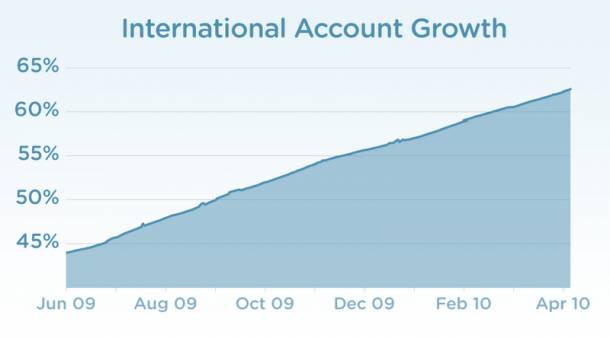For all the hype and all the discussion, the thousands of apps surrounding the service and our constant amazement at how fast or slow it grows, one point noted in a Twitter blog last night might bring us all back down to Earth for a moment – Twitter just became multilingual less than six months ago.

If you’re wondering, there are as many, if not more, Spanish speakers in the world as English. While Twitter is bragging about its expanding international audience, the next time you find yourself wondering why the service hasn’t absolutely exploded on the worldwide stage, look at its translation issues.
Now, this wasn’t the main point of Twitter’s blog post, which tells us that more than 60% of Twitter accounts come from outside the U.S. But, it didn’t seem like a rather noteworthy point.

According to the company, the addition of a Spanish-language Twitter website saw an “immediate 50% boost in signups from Spanish-speaking countries.” After the earthquake in Chile, signups “spiked 1200% and nearly all of those were using Spanish as their language.”
The reason we make this comparison is to remind ourselves of how infantile Twitter really is. We compare it to Facebook all too often, and that much-repeated statistic of 400 million users, but we don’t bother to note that Facebook is also translated into more than 60 languages.
So, while Twitter is not only striving to reach mainstream America, it is still only offered in two languages and it’s a bit of a surprise that it’s become as international a service as it has. While the blog brags that Indian politicians have spurned a recent growth in India, the country is also host the second largest number of English speakers worldwide.
Jack Dorsey on Translation
When ReadWriteWeb founder Richard MacManus recently spoke with Twitter co-founder Jack Dorsey and artist, architectural designer, activist and blogger
, the question of translating Twitter was a central theme of the discussion.
“Why don’t you provide a Chinese language access to Twitter? Once you have this, you will have 100 times more audience,” asked Ai Weiwei. “Is it possible for you to provide Chinese access to Twitter? I need a clear answer, yes or no.”
“I would say yes, its just a matter of time,” replied Dorsey. “It’s a matter of getting over techinical restraints.”
Dorsey explained that translation was an issue of scale and said that, just as was the case with Facebook, Twitter was being translated by its users. Dorsey admitted that if Twitter were translated into a local language, the people would immediately understand it, but that “it’s a major failing of the technology right now that it’s not.”
“The end goal,” Dorsey said “is end-to-end translation in every language.”
Our own Frederic Lardinois detailed Dorsey’s explanation of the translation setbacks on Twitter:
According to Dorsey, it is just a question of time and mostly a technological issue. Given Twitter’s problems with scaling the service, making it work for every character set creates some issues for Twitter because of the legacy framework that Twitter established in its early days. Currently, the company doesn’t really have the resources to devote to this. Doresey did, however, argue that users already know how the service is meant to work and understand the setup of the Twitter page.
We do have to ask – how hard is it to translate the little text we actually interact with on Twitter? Facebook, with all of its advertising pages, account pages, settings pages, and whatever else, is absolutely huge. Twitter, on the other hand, is rather small. We’re pretty sure Twitter would have no problem finding some Chinese speakers to translate the login page and the account settings and whatever else, pro bono. And, as noted in the conversation with MacManus, Ai Weiwei and Dorsey, the benefits of a more translated Twitter could be world-changing.
What say you, Twitter? We say get to it.





















